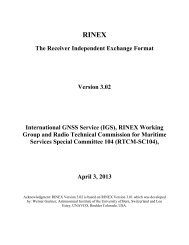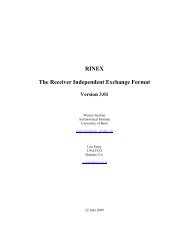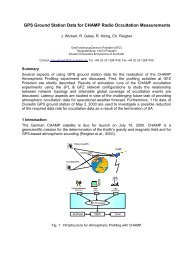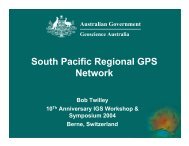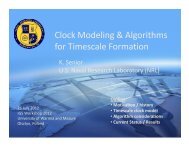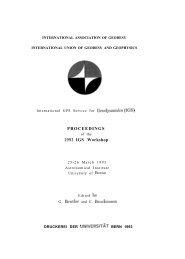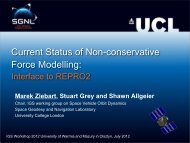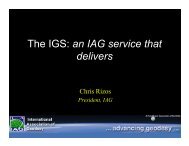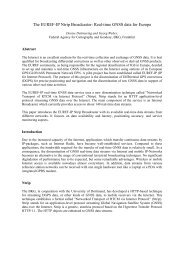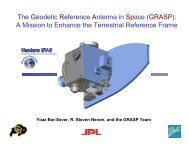IGS Analysis Center Workshop - IGS - NASA
IGS Analysis Center Workshop - IGS - NASA
IGS Analysis Center Workshop - IGS - NASA
Create successful ePaper yourself
Turn your PDF publications into a flip-book with our unique Google optimized e-Paper software.
The first field identifies the record as being an ephemeris record, the second field identifies the<strong>Analysis</strong> <strong>Center</strong>, and the third field identifies the pm. The next group constitutes a GPS time tag,followed by Cartesian earth-fixed coordinates. The record ends with some orbit accuracy field (wesuggest the natural log of the 3drms error, in meters, which would give 10% resolution with onedigit, and plenty of dynamic range). The fields in the above format are also pretty obvious, just byinspection,With such a format, all of the file manipulation chores mentioned above are trivial using basicoperating system tools. And orbit comparison is also simple (essentially a join operation to matchup pm’s and time tags between two files), Furthermore, the inclusion of a time-dependent orbitquality indicator could be very useful for maneuvering satellites. Better still for such satellites, theformat allows for easy inclusion of high-frequency satellite coordinates during a maneuver(provided the maneuver is modeled).While it is true that the size of the file would be larger (because of <strong>Center</strong> identifier and time-tagrepetition), this seems fairly unimportant when the files are actually saved in some genericcompressed format. As an example, a file in the above format was created for Saturday of GPSweek 713. Its size is 187 Kilobyte, about 30% larger than jp107 136.sp3. When compressed,however, it is 56 Kilobyte, compared to 49 Kilobyte for the compressed sp3 file. The 15%difference in the size of the new file arises because it actually contains more information than the.sp3 file, namely, orbit quality as a function of time.Before moving on to earth orientation and summary files, some mention should be made of thecurrent <strong>Center</strong>-to-<strong>Center</strong> orbit comparison procedure. Every day, each 2-<strong>Center</strong> subset of the 7-<strong>Center</strong> set is used in an orbit difference calculation. Denote by dx(t,i,j,p), dy(t,i,j,p), and dz(t,i,j,p),the Cartesian differences between <strong>Center</strong>s i and j of the location of satellite p at time t. The rmsover times and pm’s, common to both <strong>Center</strong>s, of sqrt(dx*2+dy*2+dz*2), is used as the orbitcomparison metric.One undesirable quality of the rms statistic is that it is extremely sensitive to the very poorestagreements. Consider the case where one prn is badly behaved on a given day. <strong>Center</strong>s that excludesuch a pm tend to fare better in their orbit comparison values than those that include it. Onesolution would be to use the median of sqrt(dx A 2+dy A 2+dz A 2) as a statistic rather than therms, since the median is not at all sensitive to either the best or worst agreements. Another solutionwould be to exclude the one or two pm’s with the worst agreement (rms over time) in the grand rmscalculation.Earth OrientationExcept for NGS, all <strong>Center</strong>s submit .erp files with Earth Orientation Parameters. Table 3 identifieswhich of the fields, as originally defined in <strong>IGS</strong> Message 10, are included in .erp files, as a functionof <strong>Center</strong>. A 15th field, not in <strong>IGS</strong> Message 10, is used by two <strong>Center</strong>s to indicate the time span ofthe observations.9




